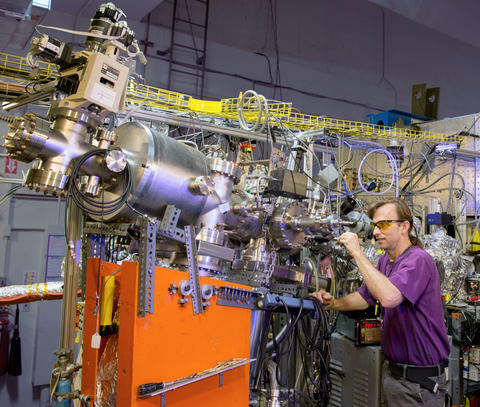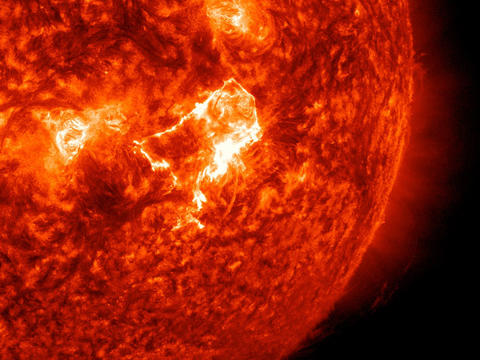
Rob Vest at the section of the EUV beam line where the degradation-free spectrometers were calibrated. Credit: Sean Kelley/NIST
Thanks to precision calibration measurements recently performed at NIST, satellites may soon be looking at sunlight with new and improved vision.
On July 22, NASA launched a rocket carrying two experimental instruments designed to measure the amount of extreme ultraviolet (EUV) solar radiation that arrives at Earth and impacts the upper reaches of the atmosphere, where EUV photons can tear the electrons off atoms and alter the electrical properties of the ionosphere.
Total EUV irradiance is a key component of global climate models, and monitoring it is vital to understanding the dynamics of "space weather" which affects global communications, power grids, and the GPS system, among other critical infrastructure. Measuring it in the long term, however, is a difficult business.
"Researchers need accurate and consistent data about specific wavelengths over extensive periods to determine how changes in solar irradiance influence our planet's space environment," says Rob Vest of NIST's Sensor Science Division, who performed the calibrations. "But there is so much energy in EUV that the instruments are prone to degradation from the very photons they measure, and that can cause substantial calibration drift over time."
Correcting for the drift, NASA says, requires expensive technologies, and may require multiple launches to compare readings from satellite sensors to identical duplicate units kept on Earth and carried aloft by sounding rockets.
That problem is the motivation behind the NASA's Degradation Free Spectrometers for Solar Physics (DFS) program and the July rocket flight intended to test the performance of two different degradation-free instrument designs. Neither has optical surfaces or thin-film filters to degrade. Both were calibrated at NIST on a beam line of the Synchrotron Ultraviolet Radiation Facility (SURF III).
The principal EUV wavelength band of interest is around 30.4 nanometers.* In that range, each photon has about ten times more energy than the UV radiation that causes sunburn. 30.4 nm is the dominant wavelength in total solar EUV emissions, and increases in its intensity are used to predict solar flares – torrents of charged particles that can wreak havoc on Earth's space environment. There are decades of observational data at 30.4 nm, and it is essential to extend that record with accurate measurements.
And, of course, they can damage instrument components. To counter those effects, DFS scientists designed one instrument that uses a unique dual grating system** to remove all light except the desired wavelength prior to measurement by a photodiode. The other, "optics free," design exposes neon atoms to EUV. When those photons strike the atoms, electrons are emitted. An attached device measures the number and energy of the emissions, thus characterizing the light.
"There are much larger synchrotrons that can produce much more intense EUV and x-ray radiation," says Tom Lucatorto, leader of NIST's Ultraviolet Radiation Group. "Using them for this work, however, would entail a great deal of shielding from hard x-rays, throwing away a lot of 'waste' radiation, and using only a small fraction of the EUV output. But SURF III, with a diameter of 1.7 meters, operates at a lower energy and emits very few hard x-rays. In addition, we have unsurpassed ability to provide the kind of absolute measurements required for calibrating the new instruments."
Researchers are still analyzing the data from the qualifying flight, but are confident of their instruments' capabilities. "Calibration at NIST/SURF provides a valuable measurement of the absolute sensitivity of solar EUV instrumentation," says DFS principal investigator Leonid Didkovsky, Director of the University of Southern California's Space Science Center. "Over the course of long-term missions aboard space-based observatories, this sensitivity is subject to change since components such as thin-film metal filters and reflective optics, on which EUV instruments typically rely, are susceptible to degradation over time. The DFS Optics Free Spectrometer and Dual Grating Spectrometer designs do not use such optical components and thus advance the state of the art of EUV instrumentation in terms of long-term stability."

For studying various aspects of solar variability, "data with high absolute accuracy are imperative," says DFS scientist Seth Wieman, "and because solar variability occurs over a wide range of timescales – from seconds to decades – this accuracy must be maintained over long time intervals. NIST/SURF calibration has demonstrated the performance of the DFS instruments, and their flight-worthiness has been proven with the recent sounding rocket mission."
* Scientists also study other EUV wavelengths, including 58.4 nm and 121.6 nm. But neither has sufficient energy to ionize helium (He). Photoionization of neutral He, which flows in from space outside our solar system, provides important information about the local interstellar medium.
** When light strikes a diffraction grating, it is split into its constituent wavelengths, each of which travels at a different angle -- analogous to what occurs when light passes through a prism. This phenomenon is the basis for many familiar types of spectrometers. The DFS design uses two "transmission" gratings in which the dispersion occurs as light passes through the gratings.

